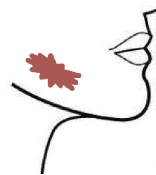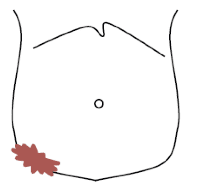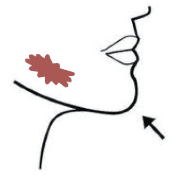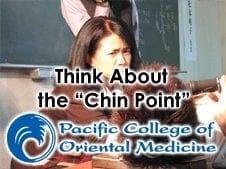By Kiiko Matsumoto, LAc & Monika Kobylecka, LAc
In the United States, as many as 50-70% of kids wear braces; many adults also use these and other orthodontic devices. Requests to take pressure off a painful or tight TMJ are all too common in our practices. While wearing enamel-protecting night guards shields the teeth from damage, it does little to reduce pain in the jaw. In kids, braces may serve as a corrective measure but they often come with a price of discomfort or even migraines.
Tightness and pain on the TMJ contributes to problems beyond the local area. There is a strong connection between pressure on the jaw and frontal lobe activity. A 2015 United Kingdom study from Cardiff University showed that the best way to remove a song that is stuck in your head, also known as an earworm, is by chewing gum1. Serge Obyper conducted a study at St. Lawrence University that showed that chewing gum before a test improved test scores2. These and other studies suggest that the jaw may be a key to accessing certain functions of the brain. It may also provide a clue as to why we often press our hand or finger up to the chin when deep in thought – Rodin’s sculpture The Thinker is a good example.
Chin – “mental area” and Ren Mai
In anatomy texts, the chin is often called the “mental area”. In the Chinese Medicine Classics, the Ren Mai is described in Su Wen chapter 60 as moving up above the neck, to the chin, then to the cheeks, before it travels up to the eyes (brain). Approximately 500 years later the Nan Ching writer, commenting on the Ren Mai in chapter 28, decides to omit the six Chinese characters that previously, in Su Wen, described the pathway of the Ren Mai above the neck. This is a calculated omission and one that is very bold for this period of time. It is possible that the reason for this brave move is that the author of Nan Ching chapter 28 considered the Ren Mai above the neck to be completely separate from the main line of the Ren Mai. In other words, the pathway from the chin and up to the brain served a different function than the main Ren Mai structure.

Clinical observations
The structure of the jaw, dental procedures, and orthodontic procedures can all have a negative impact on the TMJ. Many patients present with pressure pain on the area of St6-7, which serves as a good reflex area for these problems. Consider checking it in patients that:
- Complain of jaw tension
- Wear braces or have a history of orthodontic procedures
- Have had surgery to restructure their jaw alignment
- Have an overbite
- Have a very narrow jaw structure with a pointed chin
- Have depression and possibly other emotional problems associated with the frontal lobe
- Have head injuries to the front of the head (as well as contra coup areas)

You will find that many of these patients present with pressure pain in the St6-7 area, usually more on one side than the other. You may also find that in these patients there is tightness in the following areas:
- One side SCM
- Behind GB21 area (TMJ point)
- ASIS pressure pain – especially if one side is worse than the other
- Shoulder problems affecting one side

In all of the above-mentioned cases, the “chin point” can produce very good results. Needle it in the exact location that reduces pressure pain on the St6-7 area. Usually the best needle direction is upward, toward Du20. This point will reduce the pressure exerted on the jaw. When pressure pain is reduced or eliminated from the reflex at the St6-7 area, there is often a more systemic effect as well. Using the “chin point” produces a balancing effect on the horizontal/vertical aspects of the body and works well in cases where there are structural symptoms asymmetrically affecting one side more than the other, such as shoulder pain, jaw pain on one side, and ASIS imbalance.
Clinical example
A journalist in his forties came to the clinic with the chief complaint of insomnia and headaches. He also suffered from a lot of tightness in his shoulders. His stressful job and constant last minute deadlines had put a lot of pressure on him and his sleep was severely affected. He had been taking the sleeping pills his doctor had prescribed for a while, but was noticing decreasing effectiveness over time. He had been having trouble with his sleep for so long that by the time he reached age 40, he looked more like someone a decade older. The headaches were tied to the lack of sleep. He also reported that when he did fall asleep, he would grind his teeth so much that it disturbed his wife’s sleep.
On examination, he presented with a very rapid pulse and an overall sympathetic type presentation. The St6-7 area was extremely painful and he had a lot of pain on Du20, with heat coming off the area when touched. He reported that he often felt like his “head was too hot to allow him to sleep”.
Since he had strong pressure pain and heat in the area of Du20, the first treatment approach tested was “oketsu in the head”3. When tested, this combination of points only produced about a twenty percent change in the pain on Du20 and little change in the St6-7 area. However, pressing on the “chin point” significantly reduced pressure pain in the St6-7 area and almost immediately made the patient say “That’s it! I love this point.” After leaving the patient in the room for 10-15 minutes, the patient was asleep on the treatment table.
In a follow-up treatment, the patient reported improvement in his sleep. He continued to wear a night guard because he was still grinding his teeth, but the pain on Du20, the heat on top of his head, shoulder tightness, and headaches were all reduced. In follow-up treatments, additional points were incorporated (adrenal treatments, TH5, and so on) to reduce his sympathetic dominance, but the “chin point” continued to produce the greatest change of the reflexes and created the most dramatic shift in his symptoms.
__________________
C. Philip Beaman, Kitty Powell & Ellie Rapley. The Quarterly Journal of Experimental Psychology. Volume 68, Issue 6, 2015. pages 1049-1057
Onyper SV, Carr TL, Farrar JS, Floyd BR. Cognitive advantages of chewing gum. Now you see them, now you don’t. Appetite. 2011 Oct;57(2):321-8.
For more information on this treatment strategy and diagnosis, see Kiiko Matsumoto’s Clinical Strategies, Vol. 1 & 2.
Kiiko Matsumoto is internationally known for her scholarly work on acupuncture and the interpretation of Chinese Classic texts. She is best known for her ability to integrate the work of very important Japanese Masters, including Master Nagano, Master Kawaii, and Dr. Manaka. Ms. Matsumoto practices in Newton Highlands, MA and teaches all over the world. She is currently collaborating with Monika Kobylecka, LAc on a clinical textbook that describes Ms. Matsumoto’s latest work. In addition to this collaboration, Ms. Kobylecka practices Kiiko Matsumoto Style (KMS) acupuncture at Children’s Hospital Los Angeles (CHLA) and teaches hands-on introductory classes in KMS acupuncture.
